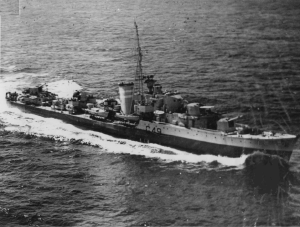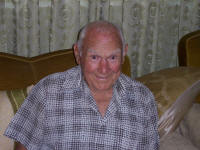Interview with George Ramsay
In October 1941 an Australian destroyer HMAS “Norman” visited the
Soviet North two times. She brought with her the British Trade Union delegation
which came to express support to the anti-German war effort. It was one of
the first Allied naval ships to have come to


Amongst the HMAS “Norman” crew was a young Perth-born sailor George
Ramsay (on the photo to the right - year 1941). He joined the RAN before the
WWII broke out and later took part in fierce battles against the Italian Navy,
German U-boats and Luftwaffe in HMAS “Sydney” and “
Herewith is an interview with him:
George, please
tell about your stay in

Did you socialize
with the Russians?
No, not really. We could not speak Russian, there were no interpreters. To tell you the truth, the Russians treated us with suspicion – we could feel it. There were female sentries with rifles on the wharf and always tried to chase away children which wanted to deal with us. But once we went to a certain place, kind of a compound or a cowboy house, which was only 5 minutes away from the wharf, where people drank and even made love (somewhere in the corner). We had a few beers in this very small canteen. The drink was quite basic and not of a great quality. It was kind of a railway signal box and when our time expired we were thrown out but the woman which ran the place – thrown us into the snow from a height of couple of meters.
What did you
know or think about
I didn’t know anything about
Did you have
a chance to meet your former enemies and allies after the war?
Yes, I am the President of the “HMAS “Sydney” Association” and I have met with the surviving Germans from “Kormoran” and Italians from “Bartlomeo”.
And what kind
of atmosphere was it in?
Friendly, but no hugs and
kisses: we used to shoot at each other… I still remember as we were trying
to pick survivors from the destroyer “Espero” the Italian bombers attacked
us as though didn’t want us to save their countrymen. Those Italians were
happy to survive and grateful to us (George shows a photo with
wet, covered with oil but smiling Italian seamen – VK). We gave them
dry clothing, food and tried to cover their wounds.
Did you read
the books “The
I read both and liked “The Cruel Sea”, found it realistic but “HMS Ulysses”, from my point of view, contains a fair bit of exaggeration.
Do you reckon
that depth charging of a U-boat, as it was described by Nicolas Monsarrat
in “The
They had no choice – that was at war and they acted under orders. But I would not like to do it myself or to take such a decision.
Do you believe
the Germans from “Kormoran” machine-gunned the survivors from the “
No, I don’t think so. They opened fire with a lot of small caliber AA-guns for half an hour and definitely would have killed most of people on the upper deck. But they would not have killed anybody in the water. The rest died with the ship.
Please tell
what you would like to say about WWII.

I feel now that I missed
a lot. I was only a young bloke and many things which I could have done and
seen went past me. I look around me now, see a lot of young people surfing
or riding motorbikes, chasing lovely girls etc. and I envy because I never
had it during 6 years of war. I had a relationship in England it was purely
platonic and eventuated in nothing as we were transferred to the Indian Ocean.
I was happy when the war was over and we won.